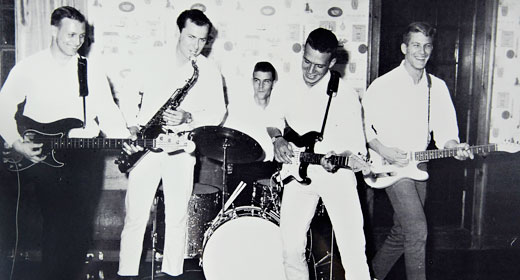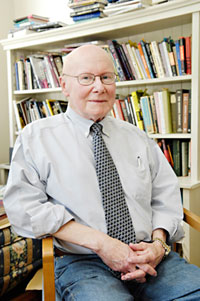
Jazz Man

Above: Nye, spring 2011. Featured photo: Nye playing saxophone for the Barnstormers in the mid-1960s.
It turned out to be a good thing that William P. “Bill” Nye couldn’t stand hospitals. Medicine’s loss was Hollins’ gain.
The longtime sociology professor, who retired in June after thirty-six years at Hollins, started out as an undergraduate major in biology, with the plan to become a doctor. His aversion to hospitals inspired him to switch to dental school, an education that lasted exactly a day. “I decided I didn’t want to look into people’s mouths the rest of my life,” he said, so he started to investigate what else would keep him interested professionally—and that led to studying and then teaching sociological theory.
But before the sociology Ph.D., before plans to attend medical and then dental school, before the biology degree, came jazz—which trained Nye to be comfortable with improvisation, in his life and in his career.
Nye’s musical education began in high school. “I had a really good teacher,” he said, “the best in the state [Conn.] at clarinet and saxophone. I got the rudiments of that down. And I started learning songs and how to improvise.” When Nye was an undergraduate at Tufts (he graduated in 1965), he played saxophone for the Barnstormers, one of the most popular college rock bands at that time in the Northeast. And for many years he has played in his own jazz combo, the Bill Nye Jazz Quartet, performing during Hollins reunions and other events on campus and around the region.
Nye’s interest in jazz persisted past graduate school and began to take shape in the classes he taught. In the early 1980s he studied jazz great Charlie Parker during a yearlong post-doctoral fellowship with the Smithsonian Institution’s Folklife Program. He has taught numerous courses centered on or containing jazz themes, including Jazz through Film. “If you look at the history of the twentieth century,” he said, “the history of jazz and history of movies coincide beautifully.” (By the way, Nye is lukewarm about Clint Eastwood’s Charlie Parker biopic, Bird, and enthusiastic about ’Round Midnight starring Dexter Gordon.)
As a professor, Nye said, “I do a lot of improvising. That’s what I love about jazz. It still takes a lot of preparation. What you do is prepare yourself so well that when you go into the classroom it’s like turning on a faucet. It just comes out. It sounds spontaneous, and it is, except that I have this reservoir.”
The kind of spontaneity Nye responded to so well in jazz drew him to the study of sociology, which was undergoing fundamental changes in the late 1960s, when Nye entered graduate school. It “had to do with catching up with [other] changes in society,” he said. “In the 1950s, Talcott Parsons, a sociologist at Harvard, established a perspective called structural functionalism: society is made up of parts, and every part serves a function. Starting in the ’60s it became much more complicated. [UCLA sociologist] Harold Garfinkel looked at how we go about constructing everyday reality as active participants and not as judgmental dopes. It was a reaction to behaviorists.”
Nye himself was interested in George Herbert Mead’s theory of the development of the self. Mead (1863-1931) was an American philosopher, psychologist, and sociologist who believed that “the self is a pure process,” said Nye. “It changes from moment to moment, but we have this notion of a permanent self, which is a creation of our minds. A student goes out and gets drunk on Saturday night and says, ‘I wasn’t myself.’ Who were you, then?” Still, says, Nye, it’s easy to believe that we stay the same, regardless of circumstances. Our family and friends “conspire to that. In most families you have rules: so-and-so is the smart one, so-and-so is the funny one. And they expect you to be that person when you go back home. It’s hard to resist.”
In a sense, then, you could say the self is improvised, made up as you go along. And as Nye progressed from undergraduate to graduate school, like many others he had to think on his feet as America went through various upheavals in the late 1960s. He was in New York City during the Newark riots of 1967. Looking for a dissertation topic, he decided to combine his interests in the self and race relations to write about Self, Color and the American Dilemma.
Nye’s interest in race relations—he has taught courses on the topic since his first teaching position—led to his being chosen to train for and lead diversity seminars at Hollins. He was certified to facilitate diversity training at the Healing the Heart of Diversity program at the Fetzer Institute in Kalamazoo, Michigan (2000-01), designed by former Hollins trustee Pat Harbour.
One of the most memorable people Nye met during his training at Fetzer was a member of the Ojibwa tribe, “a healer with an incredible presence. In the work I did with him in diversity, he gave me the name Wigwaasimitig. It stood for ‘white birch man.’ He said the white birch is a very important tree in his culture. I’m like the tree because I’m white on the outside but a true friend to Native Americans. It was quite an honor.”
Nye taught diversity seminars at Hollins for two years to groups of about a dozen campus members at a time, who met weekly each semester to discuss “the major dimensions: race, class, gender, and sexual orientation.” Training came to an end in 2001, however, not only at Hollins but at Fetzer as well. “Somehow, companies stopped giving money to employees for these things after 9/11. Right now, people don’t talk about diversity,” he said. “They’re talking about terror or airports.”
Nye’s thirty-six years at Hollins have been good ones. He has seen the school change “from when the traditional student was white and middle to upper middle class” to a school with greater diversity. “For a sociologist it’s much better to have a variety of students,” he said. “I’ve been very fortunate to find something I like to do in a place I like to do it. I was meant to be a teacher, and I flourished at it.”
Jean Holzinger is editor of Hollins magazine.
